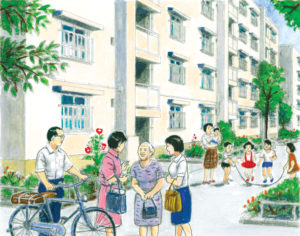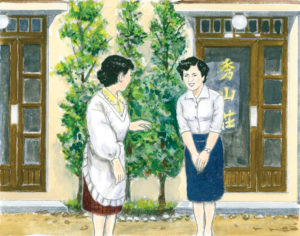Chapter Summary

Illustration courtesy of Seikyo Press.
On October 24, 1973, the business professionals division, the farming communities[1] division, housing complex division and the executives division were established with the aim of helping their members contribute to their communities and society based on faith.
On February 2, 1977, Shin’ichi Yamamoto attended the business professionals division meeting and presented several key points on winning in the workplace. He also offered one encouragement after another to members in each of these new divisions.
Members gathered for the 1st Joint Farming Communities Division and Housing Complex Division Meeting on February 17. Amid the movement of rural populations to urban areas, the farming communities division sponsored seminars to help its members acquire a broad-ranging knowledge of agricultural subjects and youth conferences aimed at fostering the next generation and reviving rural areas. Shin’ichi called on these members “to be beacons of their communities, and beacons of the Soka Gakkai” (The New Human Revolution, vol. 24, p. 328).
Meanwhile, members of the housing complex division were dedicated to creating harmonious communities in densely populated housing areas. Shin’ichi gave these members the guideline “Be the captains and chief engineers on the ship to happiness” (NHR- 24, 335). He attended the 1st Nationwide Housing Complex Division General meeting the following year on June 25, 1978.
Members of these divisions became beacons illuminating their community with the light of revitalization, showing the best course forward for society.
Unforgettable Scene

Illustration courtesy of Seikyo Press.
Consideration and Dialogue Cultivates Trust
During his youth, Shin’ichi Yamamoto lived in an apartment building where he created many friendships with his neighbors.
As a young man, Shin’ichi was always thoughtful and did his best to greet everyone in a bright and cheerful manner. It was no coincidence, he believed, that they were all living in the same apartment building; it was a sign that they had a profound connection. …
He invited the children living in the apartment next door to come over to his place to play. He also talked to the parents about Buddhism because he wanted this family to become happy, and eventually they began to practice.
Shin’ichi held discussion meetings in his apartment. He invited several other residents of the complex and surrounding area to attend. Some of them eventually started practicing this Buddhism. …
Shin’ichi lived at the Aoba Apartments for three years. In May 1952, he married Mineko. In the first days of their marriage, for about three months, they lived in a rented house in Mita, Meguro Ward; then in August they moved to the Shuzanso Apartments in Sanno, Ota Ward. It was a two-story building with a red roof, housing about ten units.
Shin’ichi and Mineko rented an apartment with two six-tatami mat rooms (98.81 square feet) on the first floor. … Both their eldest son, Masahiro, and their second son, Hisahiro, were born at the time Mineko and Shin’ichi were living in the Shuzanso Apartments. This was also the period when Shin’ichi bore heavy responsibilities as Soka Gakkai youth division chief of staff.
After they moved into the Shuzanso Apartments, Shin’ichi immediately went to introduce himself to the neighbors, giving them his business card. He wanted to build harmonious human relationships with all of them.
When Masahiro was old enough to begin running around, Mineko began putting him to bed as early as possible, so the neighbors in the apartments above and beside them wouldn’t be disturbed by the noise of him playing.
Many people visited them at that apartment. Shin’ichi had told Mineko, “Whoever comes to see us, greet them warmly and when they leave, send them off with a gift of hope.”
Shin’ichi always listened to members’ problems and encouraged them, sometimes inviting them to stay for dinner or to listen to music on the record player. Sometimes these continued into the wee hours of the night. The next day Mineko would go see the neighbors and apologize: “I’m sorry for having visitors over until quite late last night. I hope we weren’t too loud.”
Wherever it may be, sincerity, consideration and dialogue are the way to make the flowers of friendship bloom and the fruits of trust ripen. (NHR-24, 313–15)
The chapter summaries were originally published in the October 7, 2021, Seikyo Shimbun, while the “Unforgettable Scenes” were originally published in the October 14, 2021, issue.
Key Passage
The light of wisdom and conviction break through the darkness of apathy and resignation that looms over the age. Each individual needs to become a beacon illuminating his or her community with the light of revitalization to show the best course society should take. That’s the mission of the members of the Soka Gakkai. (NHR-24, 339)
References
- This group was later renamed the farming and fishing communities division. ↩︎
You are reading {{ meterCount }} of {{ meterMax }} free premium articles

